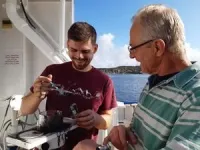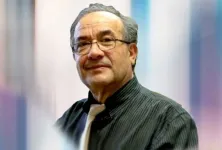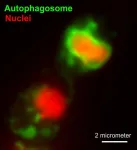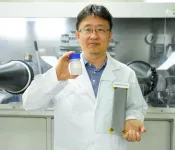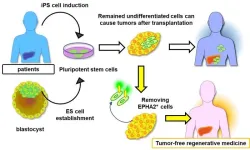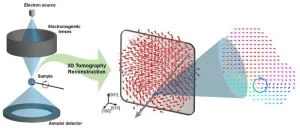(Press-News.org) The fjords on Sweden’s west coast act as effective carbon traps regardless of whether the bottom water is oxygen-rich or not. This is the conclusion of a new study with researchers from the University of Gothenburg.
Large quantities of plant parts sink to the bottom of fjords on the Swedish west coast where they form sediment. This buries organic carbon, which would otherwise contribute to ocean acidification and the greenhouse effect. When the plant parts are exposed to oxygen and other substances, the organic carbon begins to decompose into inorganic carbon, which can be dissolved into carbonic acid in the water. Research has previously assumed that it is the oxygen content of the bottom environment that determines how effectively the carbon can be captured, but measurements in three fjords in Sweden show that oxygen content plays less of a role.
Same pattern in three fjords
“We chose three fjords with different oxygen levels in the bottom water and for these fjords it seems that the amount of particles that settle is so high that the impact of oxygen on decomposition is low,” says Per Hall, professor emeritus of marine biogeochemistry at the University of Gothenburg and co-author of the study published in JGR Biogeosciences.
The three fjords; Byfjorden, Hakefjorden and Gullmarsfjorden show the same pattern in the sediments. Large amounts of organic carbon are stored, and decomposition proceeds at the same rate whether plant parts from land or sea have landed on the seabed.
“This is also new knowledge. Further into the fjords, the proportion of terrestrial plant parts is greater in the sediments than further out in the fjord, closest to the sill. But as a carbon sink, the fjord works equally well everywhere, regardless of the origin of the organic material,” says Per Hall.
Mineral particles contribute to the carbon trap
Another thing that could be noted in the measurements was that the organic material combines with mineral particles that are transported out into the fjord by water courses. This association makes the organic matter sink faster and slows down decomposition because bacteria and other organisms cannot break down this material as well. It also contributes to the carbon sink.
Fjords are the marine environments that bury the most organic carbon relative to their size. About 18 megatonnes (million tonnes) of organic carbon are buried in fjord sediments globally each year, representing 11 percent of all carbon captured in the world's oceans, even though fjords account for only one-tenth of one percent of all ocean surface area.
“Therefore, we conclude that fjords, especially those located in a temperate climate with surrounding terrestrial vegetation that can contribute to fjord sedimentation, play an important role in climate regulation on longer time scales. This emphasises the importance of exploring these ecosystems in the context of global change,” says Per Hall.
END
Fjords are effective carbon traps regardless of oxygen levels
2024-05-31
ELSE PRESS RELEASES FROM THIS DATE:
Korea University College of Medicine’s team predict hearing conditions in vestibular schwannoma patients using radiomics
2024-05-31
Korea University College of Medicine’s Team Predict Hearing Conditions in Vestibular Schwannoma Patients Using Radiomics
A recent study demonstrates that radiomics imaging analysis can effectively forecast the hearing status of patients with vestibular schwannoma patients. Since treatment methods, such as surgery or active surveillance, vary for these patients based on tumor size and hearing condition, predicting hearing status is crucial in planning and determining the appropriate treatment.
The research team led by Professor June Choi from the Department ...
European Academy of Sciences honors Rice’s Pol Spanos with prestigious award
2024-05-31
HOUSTON – (May 31, 2024) – For his “exceptional contributions to the field of dynamics,” Pol Spanos, the Lewis B. Ryon Professor of Mechanical and Civil Engineering at Rice University, has been awarded the 2024 Blaise Pascal Medal in Engineering by the European Academy of Sciences.
Spanos, who joined the Rice faculty in 1984, was recognized for his “theoretical insights, ranging from equivalent linearization to statistical quadratization, which have significantly advanced our understanding of structural behavior. These insights have not only led to more accurate predictions but have also empowered engineers ...
Rice’s Jamie Padgett wins Charles Martin Duke Lifeline Earthquake Engineering Award
2024-05-31
HOUSTON – (May 31, 2024) – Jamie Padgett, the Stanley C. Moore Professor in Engineering and chair of civil and environmental engineering at Rice University, has received the 2024 Charles Martin Duke Lifeline Earthquake Engineering Award from the American Society of Civil Engineers (ASCE).
Padgett was recognized for her “contributions to fragility, risk and resilience modeling of multimodal transportation systems and their infrastructure components when subjected to earthquakes and other hazards.”
Her ...
Sleep moderates the link between bullying and suicide in teens
2024-05-31
DARIEN, IL – A new study to be presented at the SLEEP 2024 annual meeting found that sleep duration significantly moderates the association between bullying and suicide attempts among adolescents in the U.S.
The study revealed that 15% of adolescents reported they were bullied at school, and 16% were bullied electronically; 10.2% reported they had attempted suicide during the past year; and 77.3% did not adhere to sleep duration recommendations. Adolescents who reported 4 hours of sleep or less per night were two times as likely to attempt suicide, and sleep duration significantly moderated the association between bullying ...
AI-controlled stations can charge electric cars at a personal price
2024-05-31
As more and more people drive electric cars, congestion and queues can occur when many people need to charge at the same time. A new study from Chalmers University of Technology in Sweden shows how AI-controlled charging stations, through smart algorithms, can offer electric vehicle users personalised prices, and thus minimise both price and waiting time for customers. But the researchers point to the importance of taking the ethical issues seriously, as there is a risk that the artificial intelligence exploits information from motorists.
Today's commercial ...
The world’s most powerful anti-fungal chemistries cause fungal pathogens to self-destruct
2024-05-31
Scientists have discovered that the most widely-used class of antifungals in the world cause pathogens to self-destruct. The University of Exeter-led research could help improve ways to protect food security and human lives.
Fungal diseases account for the loss of up to a quarter of the world’s crops. They also pose a risk to humans and can be fatal for those with weakened immune systems.
Our strongest "weapon" against fungal plant diseases are azole fungicides. These chemical products account for to a quarter of the world agricultural ...
Could the world famous Roman Baths help scientists counter the challenge of antibiotic resistance?
2024-05-31
The world-famous Roman Baths are home to a diverse range of microorganisms which could be critical in the global fight against antimicrobial resistance, a new study suggests.
The research, published in the journal The Microbe, is the first to provide a detailed examination of the bacterial and archaeal communities found within the waters of the popular tourist attraction in the city of Bath (UK).
Scientists collected samples of water, sediment and biofilm from locations within the Roman Baths complex including the King’s Spring (where the waters reach around 45°C) and the Great Bath, where the temperatures ...
Fast charging electric vehicles with stable high-energy density lithium-ion batteries
2024-05-31
A research team led by Dr. Choi Jeong Hee at the Korea Electrotechnology Research Institute (KERI) Battery Materials and Process Research Center, in cooperation with a Hanyang University team mentored by Professor Lee Jong-Won and a Kyunghee University team mentored by Professor Park Min-Sik, developed a core technology to ensure the charging/discharging stability and long-life of lithium-ion batteries under fast-charging conditions.
A crucial prerequisite for the widespread adoption of electric vehicles (EVs) is the enhancement of lithium-ion battery performance in terms of driving ...
Tackling the hurdle of tumor formation in stem cell therapies
2024-05-31
Ikoma, Japan – Pluripotent stem cells (PSCs) are a type of stem cells capable of developing into various cell types. Over the past few decades, scientists have been working towards the development of therapies using PSCs. Thanks to their unique ability to self-renew and differentiate (mature) into virtually any given type of tissue, PSCs could be used to repair organs that have been irreversibly damaged by age, trauma, or disease.
However, despite extensive efforts, regenerative therapies involving PSCs still have many hurdles to overcome. One being the formation of tumors (via ...
A 20-year-old puzzle solved: KAIST research team reveals the 'three-dimensional vortex' of zero-dimensional ferroelectrics
2024-05-31
Materials that can maintain a magnetized state by themselves without an external magnetic field (i.e., permanent magnets) are called ferromagnets. Ferroelectrics can be thought of as the electric counterpart to ferromagnets, as they maintain a polarized state without an external electric field. It is well-known that ferromagnets lose their magnetic properties when reduced to nano sizes below a certain threshold. What happens when ferroelectrics are similarly made extremely small in all directions (i.e., into a zero-dimensional structure such as nanoparticles) has been a topic of controversy for a long time.
The research team led by Dr. Yongsoo ...

